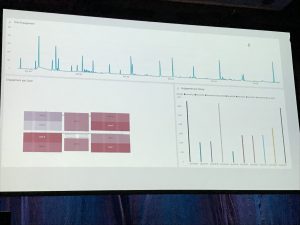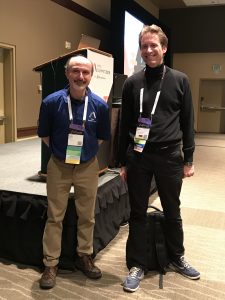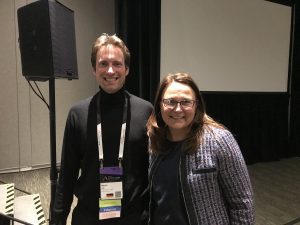Pass Summit 2019: Conference Day 1
Today was the first conference day at PASS Summit. Originally I expected the venue to be much more crowded and that there would be some sessions packed with people standing in the back. Most surprisingly it was quite a nice experience and no session I visited had people standing but instead a good share of free seats left. However Markus Ehrenmüller-Jensen told me that he has been to really packed sessions and it often is difficult for the organizers to predict how many people will be coming.
Keynote
Big part in the morning was the opening keynote by Microsoft. Rohan Kumar (Microsoft Corporate Vice President of Azure Data) presented a whole bunch of news around SQL Server 2019 and Azure assisted by demos run by Microsoft Product Managers themselves. As I already visited Bob Ward’s precon on SQL Server 2019 the Keynote did not have much news for me directly (as I am currently quite Azure agnostic 😉 ). However it was nice to see quite a few popular faces from Microsoft on stage.
However one thing sounded quite cool: SQL Server is now coming to ARM devices and thus enables IOT-Solutions where there is just too much sensor data then it can be completely transferred to a central system for realtime analytics but instead some of the tasks are carried out on the ARM IOT nodes themselves. A very nice application was that Microsoft distributed Raspberry Pis troughout the Keynote room which did analyze audience activity from clapping hands. Then they could show which part of the room was the most active in clapping. Funny thing was that the final big applause for that live Power BI data viz of the collected data immediately trumped every applause before. The footprint of SQL Server on ARM should be 300 MB…so quite decent.

SQL Server Security from the Ground up
My first session visited was about SQL Server Security by Kenneth Fisher. He did a good job explaining the basics of security as well as some best practice guidelines. As best practices he named least maintenance, least surface area and least privilege. Fair enough to say (he did as well) that these practices can be kind of contradictory (least privilege might require you to set individual permissions on object level while least maintenance is about not getting to fancy and keep things simple by putting permissions on schemas or databases and being consistent about that). Another well presented caveat also is that Best Practices are not to be followed blindly…you should know why they are best for most cases but also be brave enough to deviate if they don’t make sense in specific scenarios…he put it with the phrase “there is always one exception to the rule”.
Packaging Permissions into Stored Procedures
After lunch I visited this session by the great Erland Sommarskog. This relates to a task at work that I recently had and will now revisit with some new knowledge about permissions in stored procedure (namely that certificates for stored procedures are preferable to a EXECUTE AS statement in the procedure body). Erland also showed some great tools for keeping creating such certificates simple.
Never lose Data: digging out from corruption
This was one of the greatest sessions of the day presented by SQL Server MCM Eddie Wuerch. He discussed different ways of data loss (logical corruption like oops deletes and physical corruption like SAN write cache failures). It was a great refresher of restore techniques as well and left me with the good feeling, that I still know this stuff adequately. Eddie suggested that you should train your teams with the chaos monkey approach…someone randomly killing servers and people have to react. He stressed that as DBAs we are stewarts of the data and failing in that duty allowing data loss could result in grave ramifications like business having to close down. I very much appreciated the interactive character of the session with Eddie asking the audience every now and then and being open for questions and discussions. The absolute highlight of the day was for me as Eddie presented a hardware failure…so what did he do? He put a filegroup on a SD-card attached to his computer and then all of a sudden pulled it out and flipped it away….great show and great demonstration of true hardware loss :-).
Here’s a nice picture of me and Eddie:

From Data Munching to Wrangling: Data Preparation for Data Science
This was the last session I chose for the day. Ph.D Natasha Balac Director of the Interdisciplinary Center for Data Science at UC San Diego presented Data Wrangling techniques. I am a huge fan of UC San Diego already through the highly recommended course Python for Data Science on edX and it was great to meet with Natasha Balac someone else working at the great institution.
She delivered a great presentation about various aspects of data quality and data munging relevant for performing AI and that in a manner that novices in Data Science like me could follow along as well. Furthermore it was really refreshing to get to know some of her experience and anecdotes from projects regarding various matters of data munging. Most interestingly was for me a statement right at the beginning that a large sample of data was traditionally defined as 2 years and nowadays with higher volumes of data available and even faster changing business processes around the data just 1-2 months of data often suffices. This immediately let me bring up the question if historical data which are 3,4 or even five years old really could bring that much more value into a machine learning model and the answer was that of course it depends but historical data are of a worth for sure. However you have to take into account the business case…if you just started out with a new business process it does not help bringing old data in which don’t reflect that new process.
Here’s a picture of me and Natasha Balac:

Exhibitor reception and dinner
The evening ended with a reception of all exhibitors including a nice dinner. It was funny to eat “Uli’s German Bratwurst” in Seattle with a specific american spice taste ;-). I met Gaurav Sood again, who was sitting next to me on the flight to Seattle, as he presented his company BI Builders.